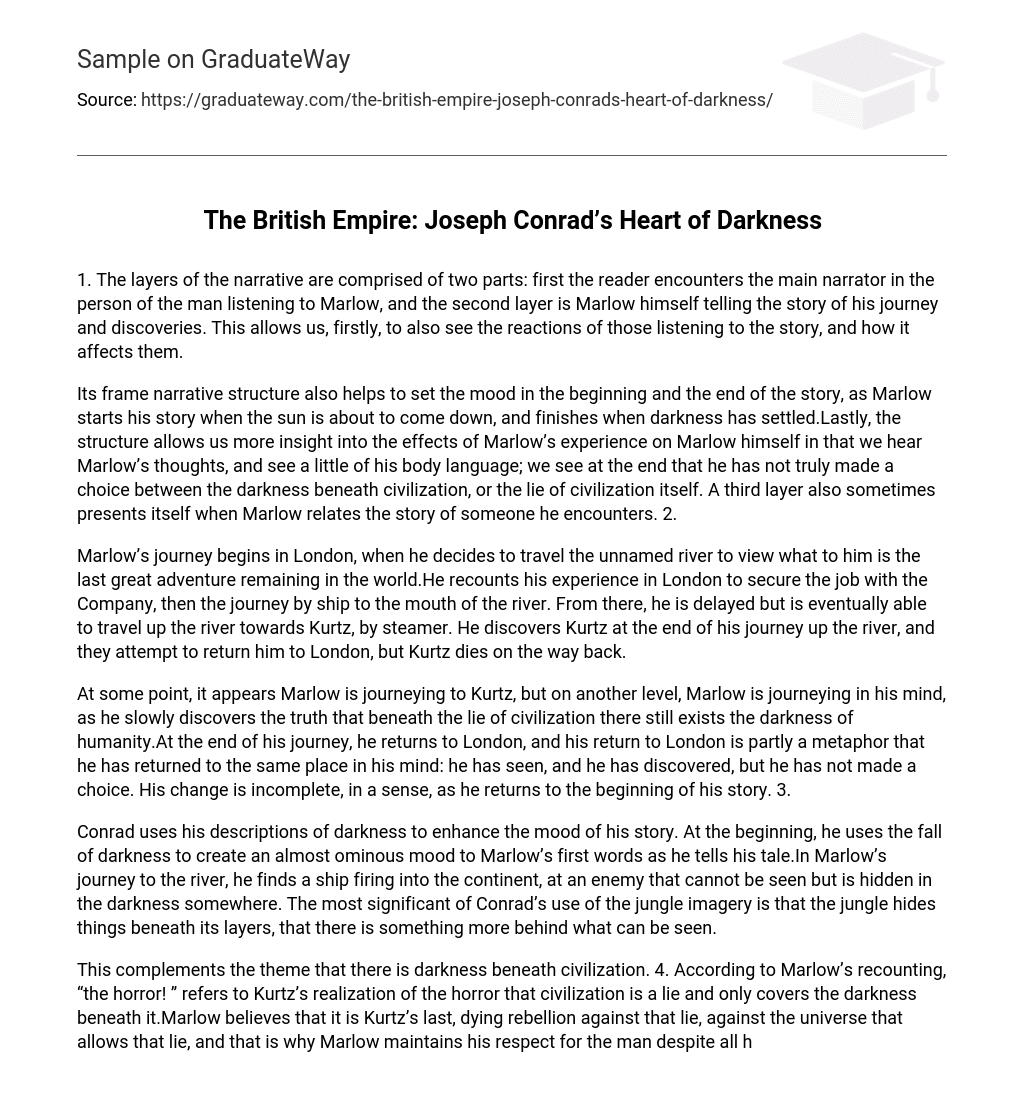1. The layers of the narrative are comprised of two parts: first the reader encounters the main narrator in the person of the man listening to Marlow, and the second layer is Marlow himself telling the story of his journey and discoveries. This allows us, firstly, to also see the reactions of those listening to the story, and how it affects them.
Its frame narrative structure also helps to set the mood in the beginning and the end of the story, as Marlow starts his story when the sun is about to come down, and finishes when darkness has settled.Lastly, the structure allows us more insight into the effects of Marlow’s experience on Marlow himself in that we hear Marlow’s thoughts, and see a little of his body language; we see at the end that he has not truly made a choice between the darkness beneath civilization, or the lie of civilization itself. A third layer also sometimes presents itself when Marlow relates the story of someone he encounters. 2.
Marlow’s journey begins in London, when he decides to travel the unnamed river to view what to him is the last great adventure remaining in the world.He recounts his experience in London to secure the job with the Company, then the journey by ship to the mouth of the river. From there, he is delayed but is eventually able to travel up the river towards Kurtz, by steamer. He discovers Kurtz at the end of his journey up the river, and they attempt to return him to London, but Kurtz dies on the way back.
At some point, it appears Marlow is journeying to Kurtz, but on another level, Marlow is journeying in his mind, as he slowly discovers the truth that beneath the lie of civilization there still exists the darkness of humanity.At the end of his journey, he returns to London, and his return to London is partly a metaphor that he has returned to the same place in his mind: he has seen, and he has discovered, but he has not made a choice. His change is incomplete, in a sense, as he returns to the beginning of his story. 3.
Conrad uses his descriptions of darkness to enhance the mood of his story. At the beginning, he uses the fall of darkness to create an almost ominous mood to Marlow’s first words as he tells his tale.In Marlow’s journey to the river, he finds a ship firing into the continent, at an enemy that cannot be seen but is hidden in the darkness somewhere. The most significant of Conrad’s use of the jungle imagery is that the jungle hides things beneath its layers, that there is something more behind what can be seen.
This complements the theme that there is darkness beneath civilization. 4. According to Marlow’s recounting, “the horror! ” refers to Kurtz’s realization of the horror that civilization is a lie and only covers the darkness beneath it.Marlow believes that it is Kurtz’s last, dying rebellion against that lie, against the universe that allows that lie, and that is why Marlow maintains his respect for the man despite all he had done.
Marlow sees it as Kurtz last struggle before death takes him. The reader, though, is presented with another interpretation, in that Kurtz could also have made the realization of what he had done, and could, perhaps be horrified by his own acts of darkness. Or that the horror itself could be that his death itself seems to have no meaning: despite the choice of civilization or darkness, death still comes.The reader is left the choice still, to accept one interpretation or the other, that choice being a significant theme in Conrad’s work.
5. According to Kipling, the White Man’s Burden, basically, is to civilize the rest of the world. The poem points out the struggles and sacrifices that are part of that burden, and points out that the burden is placed because of the superiority of the civilization of the White Man. This contrasts with Conrad in that in Heart of Darkness, the burden of the White Man is the lie of that superiority.
Heart of Darkness shows that civilization is a lie, an illusion that only hides the darkness that The White Man’s Burden claims White men should fight against. It can also be noted, however, that poem by Kipling can be read in a manner one reads a satire, and in that manner, both Kipling and Conrad are speaking on the same theme that civilization is not superior, and that any perceived superiority is an illusion only. 6. When Kurtz sees the abyss, Marlow says he embraces is because Kurtz had something to say.
Kurtz had already made his choice between the darkness and the lie, and his falling into it is just a reflection of that choice. As for Marlow, he sees the abyss, and thinks upon his choice carefully. He sees the effects of rejecting the lie and accepting the darkness in Kurtz, and he sees the effects of accepting the lie and hiding in the illusion of civilization. Marlow does not step into the abyss, however, because he cannot make a choice; he hovers between accepting the lie, and denying it completely, and finds himself a lesser man in doing so, more respecting Kurtz, who had the courage to make the choice.





